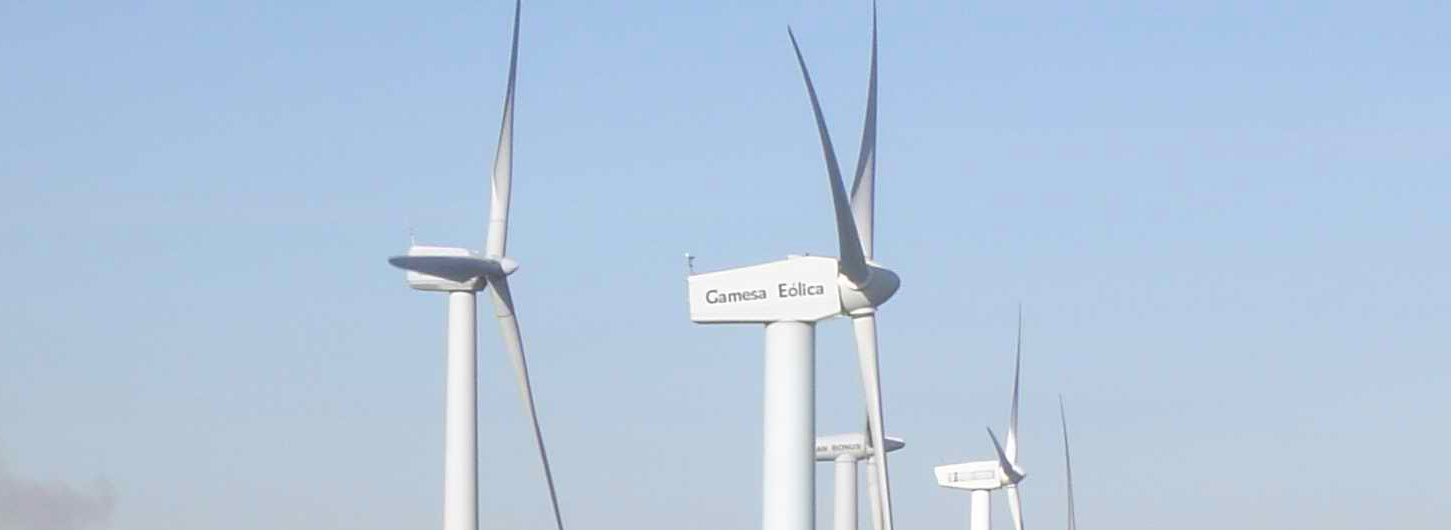Operation
THE WIND TURBINE
A wind turbine is a device that converts kinetic energy from the wind into mechanical energy.
At present, almost all of the wind turbines are of the three-bladed horizontal axis type.

WIND TURBINE OPERATION
The operation of traditional wind turbines in a manner similar to wind mills, was based on the principle of the blade’s resistance dragging against the action of the wind. This non-aerodynamic design produced an efficiency of kinetic wind energy conversion into mechanical energy, in the axis of a very small machine, to values of around 12%. Modern turbines operate under the principle of the lifting force that takes place on the blade due to its aerodynamic design, in a similar way to the wing of an airplane. Advances in aerodynamic and structural design of the blades have helped increase the conversion efficiency to values close to the theoretical limit.
The main systems of a wind turbine are:
- Capture system (Found on the outside)1
- Rotor: It includes the hub and blades.
- Blades: These are elements that capture wind energy and transmit their power to the bushing. The blades can be of two types:
- Fixed Pitch: In this type, the blade position is unchanged. For such systems, when the wind speed exceeds a certain value and it becomes necessary to limit the energy captured, the profile of the blade enters into an aerodynamic stall causing turbulence within the margins of extracted energy.
- Variable Pitch: These types vary their position, that is to say, the angle between the blade profile and the air current remains the same. The mechanical energy supplied to the turbine is controlled by changing this angle.
- Hub: It unites integral blades to the slow axis. It is coupled to the low speeds haft of the wind turbine.
- Drive System
- Slow axis: The low speed shaft of the wind turbine connects the rotor hub to the gearbox. On the inside, hydraulic or electrical cables run for the operation of the aerodynamic brakes, for the variable pitch and for the control of the rotor sensors.
- Gearbox: At its entrance is the low speeds haft which, through a system of gears, multiplies the speed of the output shaft, obtaining increased turning frequencies (between 80 and 50 times faster, depending on the model of the turbine).
- High speeds haft: It rotates at approximately 1,500 revolutions per minute (rpm), allowing the operation of the electric generator. It is equipped with an emergency mechanical disc brake.
- Guidance system
- Spindle motors: In large wind turbines, a mechanism is needed to position itself into the wind. This circular movement is achieved with engines and gearboxes fixed to the engine casing that interlock in a cog in an upper part of the tower, called a slewing ring. It receives the correct positioning signal from the turbine controller from the readings on the vane and anemometer installed on each turbine.
- Brake configuration: Their mission is to prevent unwanted radial movement of the engine housing caused by the effects of the wind or by rotor rotation. It also reduces wear on the gear placement. Its operation may be hydraulic or electric, using brake callipers or an electric motor respectively.
- Generation System
- Electric generators. They are the elements in the turbine responsible for converting mechanical energy (by rotation) into electrical energy. The electricity produced by the generator is fed to the base of the tower, where it is transformed (by increased voltage and current reduction) and sent to the network.
- Power wiring. It transports the electricity generated from the alternator to the transformer stem, through the various protections maximum or minimum voltage, over current or frequency, avoiding possible damage to the network or the turbine itself in case of contingencies in the turbine or network distribution.
- Internal Transformer. It increases the voltage generation from 690 V or 1,000 V (depending on the turbine) to 20 kV, reducing the intensity and with it electrical wastage and heating of the wiring.
- Control system
- Turbine controller. The controller continuously monitors the conditions of the wind turbine, collects statistics on its operation, and regulating switches, hydraulic pumps, valves and other components of the wind turbine.
- Control sensors. They are used for measuring physical parameters of the operation and supervising the turbine. The electronic signals are used by the electronic controller to start the turbine when the received signal is correct. The controller automatically stops the machine if the information received from the sensors is faulty, in order to protect the turbine.
- Control and regulation signals. Coming from the turbine controller and based on the analysis of sensor data, they generate commands that affect the operation and efficiency of the turbine.
- Support System
- Tower. It supports the engine casing and the rotor. It may be tubular or latticed (the latter, although cheaper, are in disuse because the tubular ones are much safer). They have several sections for easy transport. The union of the different sections is done by means of flange bolts.
- Foundation. It is the part that maintains the verticality of the structure. Its task is to absorb the stresses of the rest of the structure, transmitting them to the ground.
- Hydraulic System
- Pressure unit. It is responsible for supplying hydraulic fluid at a predetermined pressure to allow the operation of capture, guidance or transmission systems.
- Hydraulic lines. They channel hydraulic fluid to the point of use.
- Control valves. They adapt the pressure and fluid flow rate based on the action to be performed.
- Cooling systems
- Fans. They work at the request of the controller to create an airflow.
- Heat exchangers. It dissipates heat from the component to be cooled (generator, gearbox or hydraulic centre) from the airflow created by the fans.
1. The remaining systems are located inside the engine casing, which contains the key components of the wind turbine, including the gearbox and the generator. Service personnel may enter the engine casing from the tower of the turbine.
OPERATING STRATEGY
Starting the turbine
When the turbine detects wind from any direction by wind speed sensors (turbine anemometers), the controller performs the following commands to the turbine, through to the relevant engine:
- Between 2 to 3 m/s. It sends the order to position itself against the wind. This command is called orientation of the turbine.
- From 3 m/s. It disengages the brakes in order to allow rotation of the turbine and starting rotation by the effect of wind pressure only.
- Variable pitch, also sends the blade position command progressively from 90º- 0º.
- Rpm >= 1500. Upon reaching the synchronous speed of the applied generator (depending on the wind, one generator or another of different speeds is selected), the generator is connected smoothly to the network, relying on electronic power by means of thyristors (a type of continuous semiconductors which can be electronically controlled). When connecting (lasts 3 to 4 seconds), the generator is directly connected to network through a switch.
- Direct connection to the network. From this point, the generator is connected directly to the electricity grid, sending power to the national system. The velocity is constant and limited only by the mains frequency.
- Fixed Pitch. When the wind is too high, the aerodynamic design of the fixed pitch blades increases airflow turbulence, thereby limiting the power.
- Variable Pitch. The wind turbine control is performed by acting on the pitch angle, capturing or limiting the power extracted from the wind. Generation speed can be variable.
- In double winding turbines. The aim is to optimize the energy generated for different wind speed ranges, selecting one generator or another for the same function.
Wind turbine stoppage
This can occur for the following reasons:
- High winds. When the wind exceeds a margin (>25 m/s or 90 km/h), or when a fault is detected based on the sensor readings of the wind.
- Malfunction. It detects malfunctions by sensor information.
- Stoppage from too little wind. The stopping sequence is initiated if too little generation orvery low winds are detected.
- Manual stoppage. This is performed under the supervision of operating and maintenance personnel.
In the stopping of the turbine, the following procedures are identified:
- Soft Stop.
- Fixed pitch. The controller sends a command to the wind capture system to deploy the air brakes, simultaneously disconnect the generator, check the lower rpm and gently engage the brakes. After several seconds, it applies increasing brake pressure until a complete halt is achieved.
- Variable Pitch. The order is sent to the operators of the setting of the blades (pitch), increasing in degrees up to 90˚. It simultaneously disconnects the generator and performs a similar gradual increase in pressure of the secondary braking circuit.
- Emergency Stop. This occurs when faced with key faults, risk to people or turbine safety. Brakes are applied with full pressure from the start.
- Change winding generator. The turbine does not comet a complete stop, in this case, but instead the speed decreases by changing from the large to the small generator. In the opposite case, the turbine is disengaged, allowing the wind speed to increase until reaching the new synchronisation speed.

